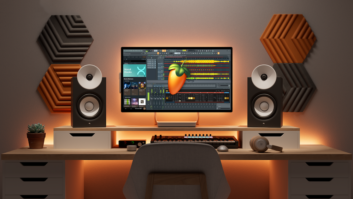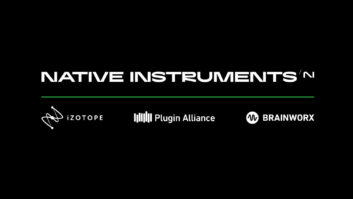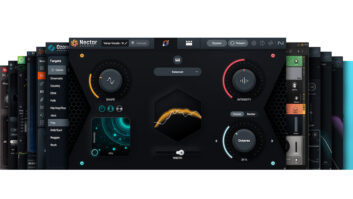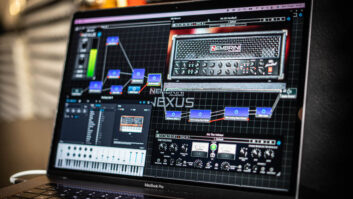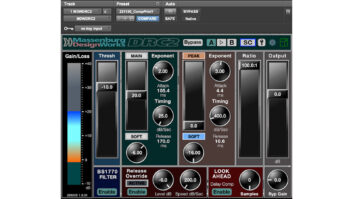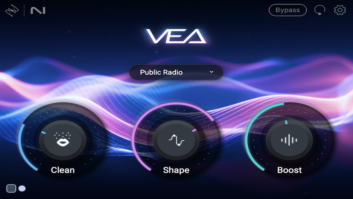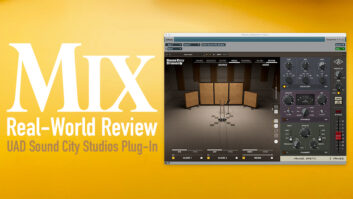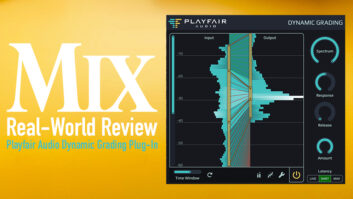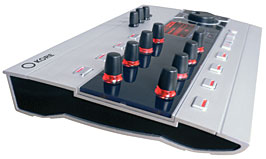
A music system that integrates hardware and software can be a beautiful thing. The components in Kore are not a radical innovation, but Native Instruments breaks new ground by combining them in a fresh way. Kore comprises two elements: a hardware control surface with programmable knobs and buttons, and a computer program that hosts VST/Audio Units plug-ins. The control surface is also an audio and MIDI interface.
In stand-alone mode, the Kore software turns a computer into a multi-timbral synthesizer. Unlike a hardware synth, though, it makes no sound of its own: Its sounds depend on the plug-ins you have installed. Kore is also a VST/Audio Units plug-in. In plug-in mode, it provides an intermediate layer between the host DAW and other plug-ins, thereby facilitating management of layered sounds and effects chains. After creating a multi-plug-in patch in Kore, you can save it as a KoreSound and later load it into a different song, a different DAW or even a different computer (as long as the same plug-ins and the Kore hardware are present).
LET’S TAKE A LOOK
When working by itself, Kore has two levels: Performance and Sound. The top level is for Performances; only one can be loaded at a time. A Performance can contain as many Sounds as your RAM and CPU will support. When Kore is operating as a plug-in within a host DAW, only the Sound mode is available. A single Sound can incorporate numerous plug-in synths and effects.
Each instantiated plug-in (at the Sound level) or Sound (at the Performance level) has its own channel strip with up to four insert effects. Each channel strip also has four sends. The send channels can be pre- or post-fader, or pre-insert — a nice extra option. Group channels can be used to adjust the levels of layered instruments and Sounds, or to add more inserts. With plug-ins that have extra outputs, you can add as many output channels as you need.

Shown: three Sounds being hosted by Kore, plus browser and current knob page.
Apart from plug-in use, Kore software also has audio inputs, so it can be used as a multi-effect plug-in. Basic EQ, delay, reverb, chorus and compression are included, but these are the only effects you can use at the Performance level; third-party effect plug-ins are available only at the Sound level.
At the Performance level, you can store multiple presets. This feature has some slick tools. You can set a crossfade time to move smoothly from one preset to another. Unfortunately, the presets don’t store all of the MIDI settings for the channels, such as transpositions and velocity curves. Nor do they store the patch selections or knob settings for synths within the Sounds, unless you’ve taken the extra step of assigning the Sound knobs to Performance-level knob layouts.
Fortunately, there’s a workaround: You can copy an entire Sound channel within the Performance, change the settings of the copy, and then store presets in which one channel or the other is muted. This process is a bit cumbersome, and requires some advance planning, but it will allow you to create a Performance in which, for instance, you can switch a soft synth within a complex setup from an electric bass to an acoustic bass instantly onstage.
SETUP AND LAUNCH
I installed Kore in my 3GHz Pentium desktop computer and used it with a wide variety of plugs, both as a stand-alone instrument and in several hosts. Kore has a surprisingly deep feature set and a rather crowded user interface, which includes a browser/database, mixer channel strips and a Page Manager for sets of user-defined knob and button layouts.
Instantiated plug-ins pop up in their own Edit windows, as in any host. The 1.01 release for Windows had difficulty displaying the Edit windows of several plug-ins, but I’m happy to report that the 1.02 release fixes all of the display problems I spotted in 1.01.
HANDY HARDWARE
The Kore hardware requires USB 2, and provides audio I/O, eight definable high-resolution knobs, eight definable pushbuttons and a few other features. In effect, the hardware unit is a dongle: The Kore software won’t run without it. If you already have more capable audio interface and control surface hardware in your studio, this will likely be an annoyance. It will also pose a problem for those who work on laptops while traveling, or who gig with a laptop that doesn’t have a free USB socket.
And replacing defective Kore hardware is bound to be more of a hassle than downloading a new license if your iLok is stolen. Let’s hope NI changes course and allows Kore to be installed using the same copy-protection scheme as their other software releases.
Studio musicians will appreciate the knobs’ smooth, solid feel and versatile programming features. And in a small studio or portable stage setup, a single box that can handle both audio and MIDI I/O will be welcome. The Kore hardware has a small, brightly lit LCD. Normally, this shows the current assignments for the knobs and switches, which can be given rather cryptic five-character names. There’s also a Menu mode, but as the computer screen will always be nearby, I’m not sure how useful accessing menus in an LCD is. When you touch a knob, the LCD switches to show its current data value.
Up/down and left/right buttons below the LCD navigate among the pages of knob assignments. This system seems a bit confusing at first, but by the time I had designed a couple of Performance presets, it started to make sense. Each knob can have numerous assignments at once, in the same or different plug-ins within a Sound, and the output values of the knob can be separately scaled for each assignment. I was able to use a single knob to control, for example, filter cut-off on one synth, oscillator balance on a second and a built-in delay’s wet/dry balance on a third — all at the same time.
WORKIN’ IT
Working by trial and error, I figured out how to assign the user knobs from various Sounds in a Performance to a single knob at the Performance level. This allowed me to crossfade parameters within two separate Sounds with one knob movement.
Assigning synth and effect parameters to the knobs is dependent on the plug-in’s VST/Audio Units implementation, which has to “publish” the parameter list to the host for automation. (Most modern plug-ins do this, but not all of them.) Kore publishes the contents of the first eight user-created pages of knobs to its host, and automating these worked as expected.
In stand-alone mode, the knobs can transmit MIDI messages through any available MIDI output port in your computer, and they receive MIDI control change messages in both stand-alone and plug-in mode. Unfortunately, if Kore is running as a plug-in, the knobs can be used only to control Kore-hosted plug-ins. To control everything else in the host DAW, you’ll need a second control surface.
Above the LCD are non-programmable level knobs for the audio inputs (unbalanced ¼-inch), audio outputs (balanced ¼-inch) and stereo headphone out, which can be used as a separate stereo mix output. The coaxial S/PDIF output mirrors the main audio outs.
The Start and Stop buttons on the hardware unit communicate with Kore’s internal clock, but can’t be used for starting and stopping host software when Kore is being used as a plug-in. Two footswitch inputs and a sweep pedal input can double the operation of buttons and knobs, respectively. A large data dial to the right of the LCD serves only to duplicate the function of the up/down buttons. In future software revs, I hope this dial will be assignable like the knobs and also usable for data entry.
EASY SONIC SEARCH
The integrated browser/database provides quick access to plug-ins and their presets. Category search words can be assigned to presets. For example, you can instantly search for warm brass suitable for funk/soul. Owners of NI’s Komplete software instrument package will find thousands of factory presets already neatly categorized. Categorizing your own presets for third-party plug-ins will be time-consuming, and there’s no way to create your own keywords.
Standard copy/paste commands can be used to combine the channel into a new composite layer. This greatly facilitates the process of reorganizing your performances for different musical situations. The company’s statement that Kore is a “universal sound platform” is belied by the fact that it won’t host DXi plug-ins and is not a ReWire host. In addition, Performances stored to disk can not be loaded into Kore when it is running as a plug-in, so it isn’t even fully compatible with itself.
MIDI MATTERS
Each channel strip in Kore, at both Performance and Sound levels, can load one or more MIDI files (either type 0 or type 1). Playback can be started or stopped from a MIDI note played on your master keyboard, and the start can sync to Kore’s bar or beat. This is a terrific feature for interactive live performance.
I tested it with a multitimbral sequence created in Cubase using Steinberg Hypersonic, and the playback worked perfectly. Kore doesn’t “zero out” pitch bend and mod wheel moves if stopped in the middle of a sequence, but this is a minor problem and easily avoided once you know about it.
I also tried dragging and dropping MIDI files from Stylus RMX into Kore, and RMX played them without trouble. MIDI files are automatically saved with the Performance.
Each channel strip also has real-time MIDI input filtering, which includes channel, key range, velocity range and event-type selection (notes, control change, channel and poly after-touch, pitch bend and program change). Several velocity curves are provided, as is a transpose parameter. Unfortunately, velocity cross-switching is not possible. A channel can be programmed to respond only to high velocities, ignoring low ones, but not the other way around.
GETTING TO THE KORE
As computers come to dominate music production, Kore is a breakthrough product — not just an entry-level audio/MIDI interface, but also a versatile control surface and a software platform that conveniently integrates synthesizers and plug-in effects. As such, it stands poised to fill a definite need.
But while it scores high marks conceptually, the initial version comes up a bit short. The fact that the hardware unit is a dongle is not likely to be popular, especially among those who already have more-capable audio interfaces and control surfaces. The knobs need to be able to transmit MIDI controller data to a host DAW, not just to the Kore plug-in. And because I use Propellerhead Reason as a software synth, Kore’s inability to host ReWire applications makes it less useful in my productions. If Native Instruments is able to address these issues, then Kore is sure to be the apple of many a musician’s eye.
Price: $559.
Native Instruments, 323/467-5260, www.native-instruments.com.
Jim Aikin writes regularly for Mix and other music production magazines.
